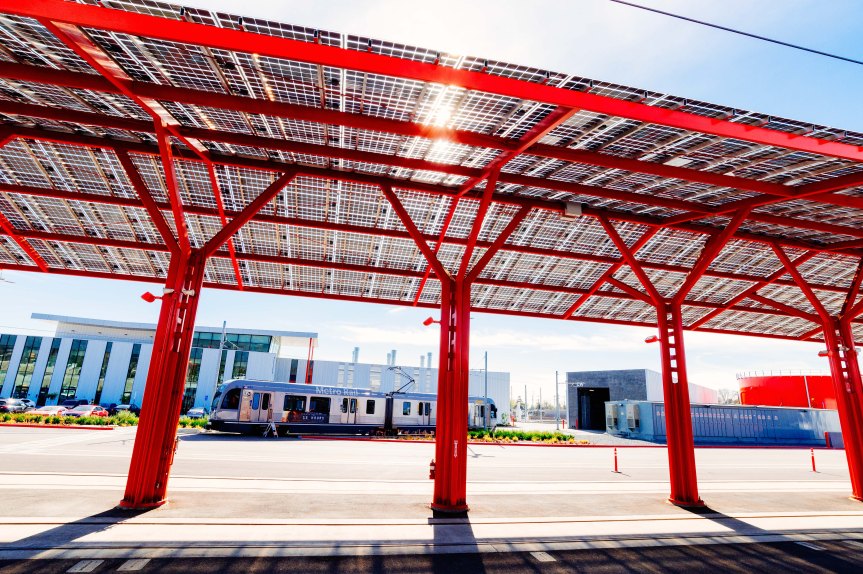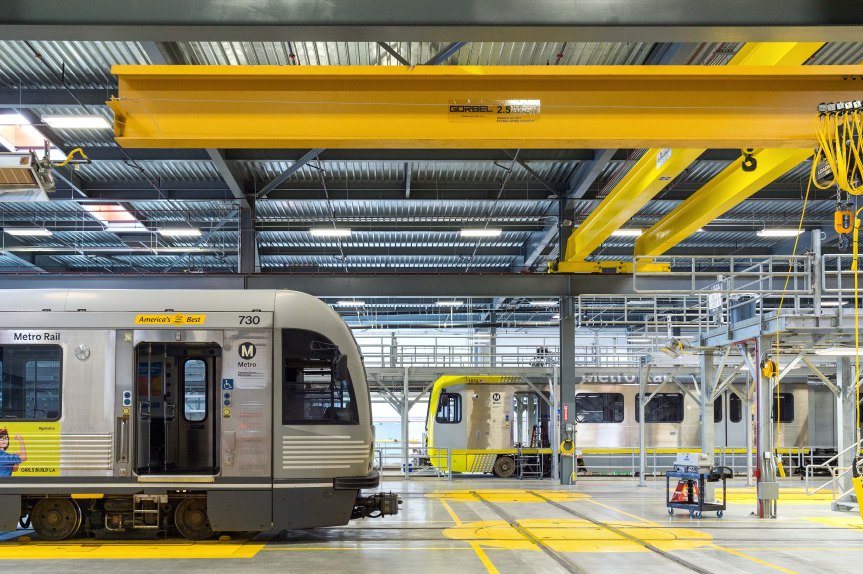The following article appeared in The Source on April 13, 2016.
U.S. Green Building Council awards Foothill Gold Line rail facility LEED Gold certification – The Source
By Steve Hymon
April 13, 2016

The outside of the maintenance campus in Monrovia and the inside of the facility below. Photos by Steve Hymon/Metro.

Photo by Steve Hymon/Metro.
Congratulations to our friends at the Gold Line Foothill Extension Construction Authority, the agency that built the extension to Azusa. The rail yard facility in Monrovia — it’s next to the big Home Depot — is a really beautiful building inside and out. And a sustainable one, too. Here’s the news release from the Construction Authority:
Monrovia, CA – Today, the Foothill Gold Line Construction Authority announced that the U.S. Green Building Council awarded the Foothill Gold Line Operations Campus main shop building its Leadership in Energy & Environmental Design (LEED) Gold Certification. The recognition for the 132,000 square foot building is one of the highest levels of achievement in sustainable design available, and makes it the first of its kind to receive the distinction. LEED is a green building certification program that recognizes best-in-class building strategies and practices.
“We challenged ourselves to look for ways to reduce the environmental footprint of the facility, because we believed that the extra effort would be worth it in the long term for the environment, community and the staff who would be working there,” stated Habib F. Balian, CEO of the Foothill Gold Line Construction Authority. “Achieving LEED Gold for this kind of facility is a proud testament to the ingenuity of our team and our partners at Parsons, Kiewit and Metro.”
While sustainability measures were incorporated throughout the 24-acre maintenance and operations facility, only those associated with the main shop building were factored into consideration by the U.S. Green Building Council in their certification award. The three-story main building houses offices and training facilities for 200 employees, a yard control room to manage all train activities on the campus, and repair and maintenance shops to service up to 84 light rail vehicles. Using the following sustainability features, the building was able to achieve 35% water usage reduction and 32.5% energy performance improvement, as compared to typical buildings of its kind:
·An on-site 714-panel, 178.5-kilowatt solar panel array that generates nearly a third of the energy needs of the main shop building, with excess energy made available to the local grid
·Solar-tracking skylights that move with the sun to maximize use of natural light
·Sensors that detect human motion as well as the level of natural light available and adjust the high-efficiency LED lighting for actual need
·High-efficiency fixtures and infrared water faucets that dispense less water
Additional sustainability features incorporated into the overall 24-acre facility that went above and beyond those needed to achieve LEED Gold Certification include:
·A comprehensive stormwater management system that captures 100% of rainfall; filtering and infiltrating the first 112,000 gallons during any rain event into the groundwater aquifers below
·Use of only recycled, reclaimed water for the carwash, which averages 60,000 gallons of water use daily
·Smart sprinkler technology and the planting of a drought-tolerant plants that reduce landscape water consumption by 50%
·Use of recycled materials for half of the building materials used on site; and locally sourcing all of the track ballast, aggregate and concrete to reduce the environmental impact of transporting them to the site
“We’ve shown that it is feasible to incorporate sustainability features into a facility of this magnitude without significantly impacting the construction budget and schedule,” added Balian. “Our hope is that this will be a model for other, similar facilities.”
About the Foothill Gold Line – The Foothill Gold Line is a $2 billion, 12-station extension of the Metro Gold Line light rail system, being overseen by the Foothill Gold Line Construction Authority, an independent transportation planning and construction agency created in 1998 by the California State Legislature. The project is planned in two segments – Pasadena to Azusa and Glendora to Montclair. The Pasadena to Azusa segment was fully funded by Los Angeles County’s Measure R, and included the Operation Campus in Monrovia. The segment was completed in September 2015, and passenger service began on March 5, 2016. Measure R is also funding the majority of the cost associated with the advanced conceptual engineering work currently underway for the Glendora to Montclair segment, which will be ready to break ground in 2017. The Construction Authority is currently seeking the $1.2 billion needed to construct the Glendora to Montclair segment.
